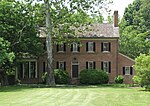Bloomsbury Farm (Spotsylvania County, Virginia)

Bloomsbury Farm (also known as Harris Farm) was an 18th-century timbered framed house, one of the oldest privately owned residences in Spotsylvania County, Virginia. The house was originally built by the Robinson family sometime between 1785 and 1790. It was architecturally significant for its eighteenth-century construction methods and decorative elements. The surrounding location is also significant as the site of the last engagement between Confederate and Union forces in the Battle of Spotsylvania Courthouse on May 19, 1864. Bloomsbury Farm was added to the National Register of Historic Places in May 2000. The house was demolished in December 2014 by Leonard Atkins, a nearby resident who purchased the property in November 2014 ostensibly to restore it. Atkins cited the building's supposedly poor condition and public safety as the reasons for the abrupt demolition, and he planned to replace the historic house with a new one commensurate in style and value with the modern houses in the surrounding development in which he lives. The farm was removed from the National Register in 2017.
Excerpt from the Wikipedia article Bloomsbury Farm (Spotsylvania County, Virginia) (License: CC BY-SA 3.0, Authors, Images).Bloomsbury Farm (Spotsylvania County, Virginia)
North Harris Farm Road,
Geographical coordinates (GPS) Address Nearby Places Show on map
Geographical coordinates (GPS)
| Latitude | Longitude |
|---|---|
| N 38.235277777778 ° | E -77.566111111111 ° |
Address
North Harris Farm Road 10099
22553
Virginia, United States
Open on Google Maps








